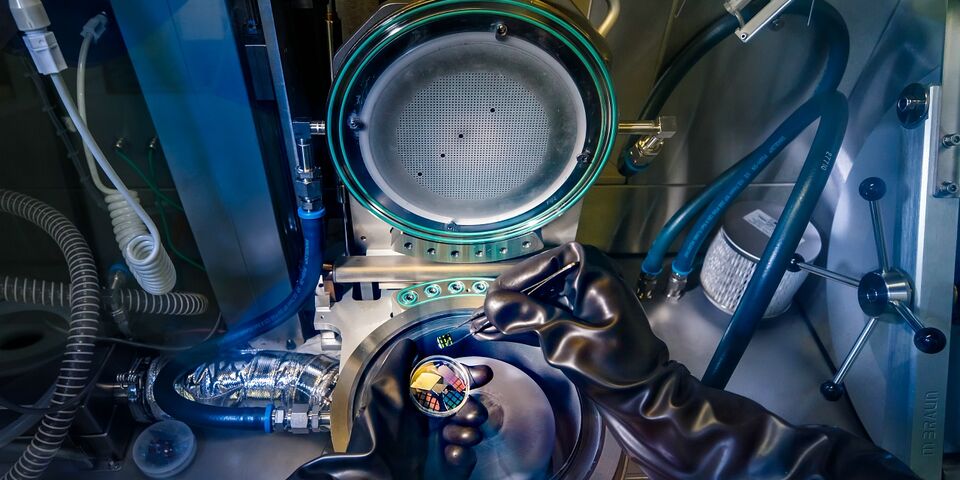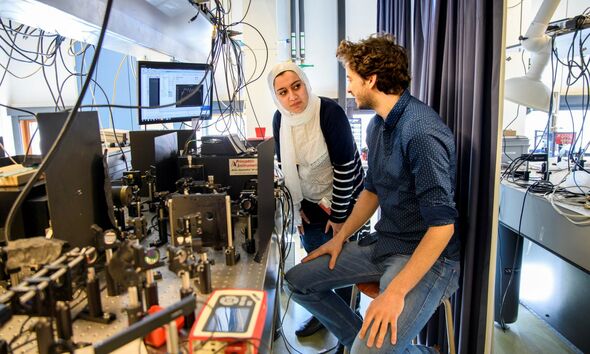TU/e researchers pave way for silicon photonic chips
Researchers led by TU/e professor Erik Bakkers have developed an alloy with silicon that can emit light, a feat which opens the way to faster and more energy efficient photonic computer chips based on standard silicon technology. The results have been published in the journal Nature. The team will now start creating a silicon laser to be integrated into current chips.
By replacing electrical communication within a chip by optical communication, the energy consumption can be greatly reduced. Moreover, the speed of on-chip and chip-to-chip communication can be increased by a factor 1000. Data centers would benefit most, with faster data transfer and less energy usage for their cooling system. But these photonic chips will also bring new applications within reach. Think of laser-based radar for self-driving cars and chemical sensors for medical diagnosis or for measuring air and food quality.
To use light in chips, you will need a light source; an integrated laser. The main semiconductor material that computer chips are made of is silicon. But bulk silicon is extremely inefficient at emitting light, and so was long thought to play no role in photonics. Thus, scientists turned to more complex semiconductors, such as gallium arsenide and indium phosphide. These are good at emitting light but are more expensive than silicon and are hard to integrate into existing silicon microchips.
To create an all-silicon laser, scientists needed to produce a form of silicon that can emit light. That’s exactly what researchers from TU/e now succeeded in. Together with researchers from the universities of Jena, Linz and Munich, they combined silicon and germanium in a hexagonal structure that is able to emit light. A breakthrough after fifty years of work.
Band gap
“The crux is in the nature of the so-called band gap of a semiconductor,” says lead researcher Erik Bakkers from TU/e. “If an electron ‘drops’ from the conduction band to the valence band, a semiconductor emits a photon: light.” But if the conduction band and valence band are displaced with respect to each other, which is called an indirect band gap, no photons can be emitted - as is the case in silicon. “A 50-year old theory showed however that silicon, alloyed with germanium, shaped in a hexagonal structure does have a direct band gap, and therefore potentially could emit light,” says Bakkers.
Shaping silicon in a hexagonal structure, however, is not easy. As Bakkers and his team master the technique of growing nanowires, they were able to create hexagonal silicon in 2015. They realized pure hexagonal silicon by first growing nanowires made from another material, with a hexagonal crystal structure. Then they grew a silicon-germanium shell on this template. Elham Fadaly, shared first author of the Nature paper: “We were able to do this such that the silicon atoms are built on the hexagonal template, and by this forced the silicon atoms to grow in the hexagonal structure.”
Silicon laser
But they could not yet make them to emit light, until now. Bakkers team managed to increase the quality of the hexagonal silicon-germanium shells by reducing the number of impurities and crystal defects. When exciting the nanowire with a laser, they could measure the efficiency of the new material. Alain Dijkstra, also shared first author of the paper and responsible for measuring the light emission: “Our experiments showed that the material has the right structure, and that it is free of defects. It emits light very efficiently.”
Creating a laser now is a matter of time, Bakkers thinks. “By now we have realized optical properties which are almost comparable to indium phosphide and gallium arsenide, and the materials quality is steeply improving. If things run smoothly, we can create a silicon-based laser this year. This would enable a tight integration of optical functionality in the dominant electronics platform, which would break open prospects for on-chip optical communication and affordable chemical sensors based on spectroscopy.”
In the meantime his team is also investigating how to integrate the hexagonal silicon in cubic silicon microelectronics, which is an important prerequisite for this work. This research project has been funded by the EU project SiLAS, coordinated by TU/e professor Jos Haverkort.
The article can also be found on arXiv.org.



Discussion